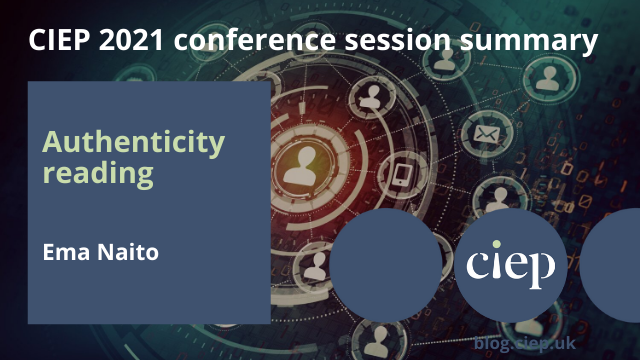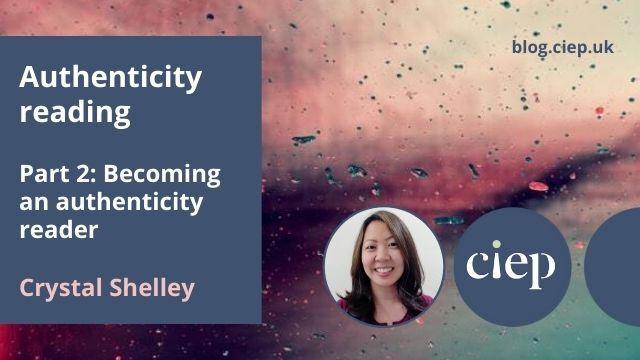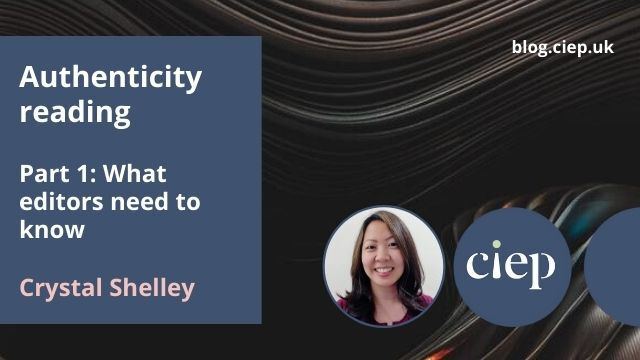This year’s CIEP conference was held online, from 12 to 14 September. Attendees from all over the world logged on to learn and socialise with their fellow editors and proofreaders, and a number of delegates kindly volunteered to write up the sessions for us. Ema Naito reviewed Authenticity reading: Helping writers craft accurate and respectful representation, presented by Crystal Shelley.
 Have you seen the video where, one by one, Black movie fans stand in front of a poster of Chadwick Boseman as Marvel superhero the Black Panther and tell him what his portrayal of the role meant to them?
Have you seen the video where, one by one, Black movie fans stand in front of a poster of Chadwick Boseman as Marvel superhero the Black Panther and tell him what his portrayal of the role meant to them?
In all these scenes, the overwhelming sentiment was the same: good representation of Black characters makes a world of difference.
The power of representation
Crystal Shelley showed us this video as an opening for her highly anticipated CIEP2021 session on how authenticity reading leads to respectful representation.
Her point: good representation matters.
Representation can shape how we see ourselves and are seen by others. Good representation is empowering and affirming; poor representation can be harmful or invalidating.
And it’s to support more good representation that authenticity reading plays a role.
What is authenticity reading?
Crystal defines authenticity reading as ‘a service that evaluates the representation of identities or experiences in writing’ – especially when the writer doesn’t have that identity or lived experience.
Many of us may be more familiar with the name ‘sensitivity reading’, but Crystal prefers ‘authenticity’ because the focus is on representing the real, lived experiences of people.
Authenticity reading evaluates the writing for biases and identifies potentially harmful elements. A reader could, for example, flag wrong words (eg the wrong Chinese word for ‘grandfather’) or words that are disrespectful, ‘othering’, condescending or misrepresentative (eg calling someone ‘exotic’ based on their ethnicity or labelling a person with a disability a ‘sufferer’).
Crystal likens authenticity reading to beta reading, where the reader gives the writer
- comments on what worked well and what may be adjusted
- overarching feedback on plot, characterisation, cultural elements (in a report)
- sentence-level feedback on inaccurate words/phrases, harmful terms, disrespectful language, etc (as comments in the manuscript)
What authenticity reading is not
Crystal debunked a few of the misconceptions about authenticity reading.
It’s not censorship. Critics say sensitivity readers are looking to be offended. But the reader (like any editor) is there to help the writer produce more credible work. And the reader has no power to censor words; the author has the final decision.
It’s not representative of the whole community. An authenticity reader is responding from their personal lived experience; they are not speaking for whole communities. And similarly, there’s no such thing as one authentic experience. Two people could identify as, say, a Black gay man but have entirely different experiences.
It’s not a stamp of approval nor a shield from criticism. Just because a work has had authenticity feedback doesn’t mean that the writing is officially sanctioned or that there won’t be people who respond negatively to the writing.
It’s only needed for heavy topics like trauma or suffering. Authenticity reading can be helpful for any kind of writing.
Who can be an authenticity reader?
You can become an authenticity reader for certain
- social identities: eg race, gender, sexual orientation, disabilities
- experiences: eg caregiving, adoption, incarceration
- subgroup culture: eg military, gaming, fandom
An authenticity reader should closely match the identity or experience being represented; sometimes multiple readers are needed.
If you want to provide authenticity reading services, you might consider things like:
- It’s an evolving field with little formal training available and no guidelines for what should be included in your offer or on pricing.
- You are being asked to draw on your pain, anger, trauma and may therefore need to set boundaries.
- You may also have to consider how to protect yourself (eg NDA, pseudonym, no acknowledgements).
Publishers and authors are increasingly aware of how publishing harmful writing could cause real reputational and financial losses. Authenticity readers can offer them a valuable service.
I don’t plan to become an authenticity reader. But do I feel I can now better explain to clients what authenticity reading is and recommend it if it might benefit the manuscript.
And as an East Asian woman who spent a good chunk of her youth in the US, seeing Crystal, an East Asian woman from North America, on the screen was itself affirming.
Good representation is important, indeed.
Read or direct your authors
- Writing the other: A practical approach (Nisi Shawl and Cynthia Ward)
- Incomplete guides (Salt and Sage Books, booklets on various topics)
- Conscious style guide
- Writing the other
- Writing with color
- Writing diversely
Directories (other than CIEP, EFA, ACES, etc)
- Editors of color database
- Quiethouse editing
- Dot and Dash
- Salt and Sage Books
- Binders Full of Sensitivity Readers (Facebook group)
 Ema Naito is a bilingual scholarly editor who loves clear, plain English. She edits for social science academics and international development organisations. Ema grew up between Tokyo and the US East Coast and is now based in Bangkok. She has a master’s degree from the School of International and Public Affairs, Columbia University, and sings classically.
Ema Naito is a bilingual scholarly editor who loves clear, plain English. She edits for social science academics and international development organisations. Ema grew up between Tokyo and the US East Coast and is now based in Bangkok. She has a master’s degree from the School of International and Public Affairs, Columbia University, and sings classically.
 About the CIEP
About the CIEP
The Chartered Institute of Editing and Proofreading (CIEP) is a non-profit body promoting excellence in English language editing. We set and demonstrate editorial standards, and we are a community, training hub and support network for editorial professionals – the people who work to make text accurate, clear and fit for purpose.
Find out more about:
Posted by Abi Saffrey, CIEP blog coordinator.
The views expressed here do not necessarily reflect those of the CIEP.





